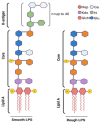The Battle of LPS Clearance in Host Defense vs. Inflammatory Signaling
- PMID: 39329771
- PMCID: PMC11430141
- DOI: 10.3390/cells13181590
The Battle of LPS Clearance in Host Defense vs. Inflammatory Signaling
Abstract
Lipopolysaccharide (LPS) in blood circulation causes endotoxemia and is linked to various disease conditions. Current treatments focus on preventing LPS from interacting with its receptor Toll-like receptor 4 (TLR4) and reducing inflammation. However, our body has a natural defense mechanism: reticuloendothelial cells in the liver rapidly degrade and inactivate much of the circulating LPS within minutes. But this LPS clearance mechanism is not perfect. Excessive LPS that escape this clearance mechanism cause systemic inflammatory damage through TLR4. Despite its importance, the role of reticuloendothelial cells in LPS elimination is not well-studied, especially regarding the specific cells, receptors, and mechanisms involved. This gap hampers the development of effective therapies for endotoxemia and related diseases. This review consolidates the current understanding of LPS clearance, narrates known and explores potential mechanisms, and discusses the relationship between LPS clearance and LPS signaling. It also aims to highlight key insights that can guide the development of strategies to reduce circulating LPS by way of bolstering host defense mechanisms. Ultimately, we seek to provide a foundation for future research that could lead to innovative approaches for enhancing the body's natural ability to clear LPS and thereby lower the risk of endotoxin-related inflammatory diseases, including sepsis.
Keywords: Kupffer cells; LPS; LSECs; clearance; endotoxemia; endotoxin associated diseases; liver; scavenger receptors; sepsis; signaling.
Conflict of interest statement
The authors declare no conflict of interest.
Figures



Similar articles
-
RAPID COMMUNICATION: TLR4 expressed but with reduced functionality on equine B lymphocytes.J Anim Sci. 2019 Apr 29;97(5):2175-2180. doi: 10.1093/jas/skz074. J Anim Sci. 2019. PMID: 30901382 Free PMC article.
-
Distinct responses of lung and liver macrophages to acute endotoxemia: role of toll-like receptor 4.Exp Mol Pathol. 2013 Feb;94(1):216-27. doi: 10.1016/j.yexmp.2012.09.006. Epub 2012 Sep 19. Exp Mol Pathol. 2013. PMID: 23000425 Free PMC article.
-
Chitohexaose activates macrophages by alternate pathway through TLR4 and blocks endotoxemia.PLoS Pathog. 2012;8(5):e1002717. doi: 10.1371/journal.ppat.1002717. Epub 2012 May 24. PLoS Pathog. 2012. PMID: 22654663 Free PMC article.
-
Lipid-mediated regulation of pro-inflammatory responses induced by lipopolysaccharide.Postepy Biochem. 2018 Oct 25;64(3):175-182. doi: 10.18388/pb.2018_129. Postepy Biochem. 2018. PMID: 30656902 Review. English.
-
Role of Metabolic Endotoxemia in Systemic Inflammation and Potential Interventions.Front Immunol. 2021 Jan 11;11:594150. doi: 10.3389/fimmu.2020.594150. eCollection 2020. Front Immunol. 2021. PMID: 33505393 Free PMC article. Review.
Cited by
-
Metabolomic Characterisation of Low-Density Lipoproteins Isolated from Iodixanol and KBr-Based Density Gradient Ultracentrifugation.Metabolites. 2025 Jan 22;15(2):68. doi: 10.3390/metabo15020068. Metabolites. 2025. PMID: 39997693 Free PMC article.
-
Citral protects against metabolic endotoxemia, and systemic disorders caused by high-fat diet-induced obesity via intestinal modulation.Front Pharmacol. 2025 Apr 7;16:1567217. doi: 10.3389/fphar.2025.1567217. eCollection 2025. Front Pharmacol. 2025. PMID: 40260376 Free PMC article.
-
Gut Microbiota at the Crossroad of Hepatic Oxidative Stress and MASLD.Antioxidants (Basel). 2025 Jan 6;14(1):56. doi: 10.3390/antiox14010056. Antioxidants (Basel). 2025. PMID: 39857390 Free PMC article. Review.
-
Sepsis-Associated Acute Kidney Injury: What's New Regarding Its Diagnostics and Therapeutics?Diagnostics (Basel). 2024 Dec 17;14(24):2845. doi: 10.3390/diagnostics14242845. Diagnostics (Basel). 2024. PMID: 39767206 Free PMC article. Review.
-
Research Progress on the Immune Function of Liver Sinusoidal Endothelial Cells in Sepsis.Cells. 2025 Mar 4;14(5):373. doi: 10.3390/cells14050373. Cells. 2025. PMID: 40072101 Free PMC article. Review.
References
Publication types
MeSH terms
Substances
Grants and funding
LinkOut - more resources
Full Text Sources
Miscellaneous

